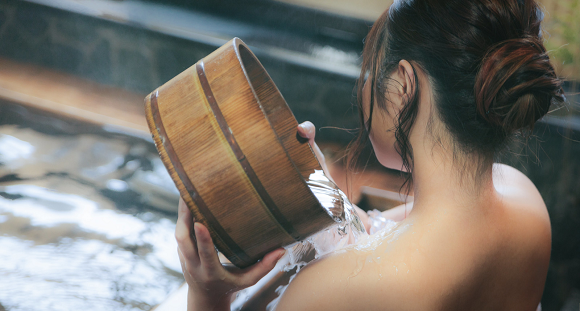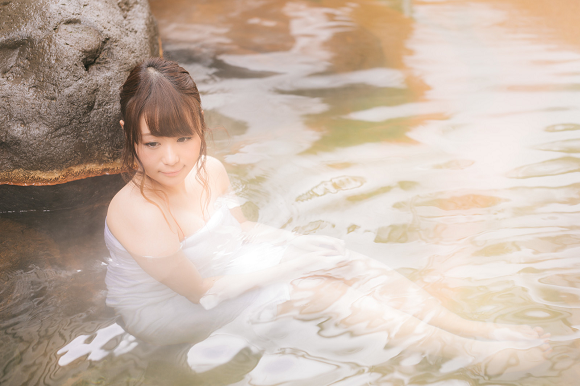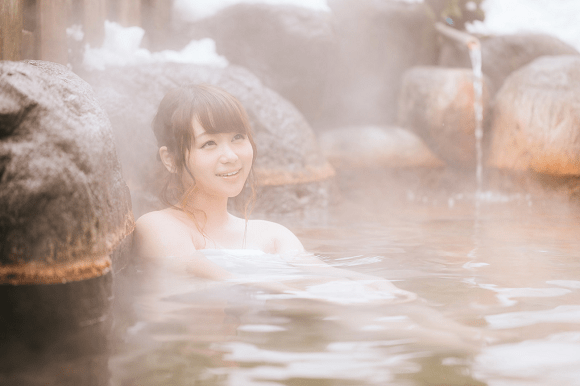
Child development expert weighs in on the tricky question, offers a solution from Japan’s samurai-era past.
While some Japanese hot springs operate under a konyoku policy, in which male and female bathers share the same tubs, for the most part bathing in Japan is gender-segregated, even when it’s communal. However, an exception is usually made for young kids.
The logic is pretty easy to follow. Sometimes, a child may be at an onsen/hot spring or sento/public bath with just one parent, and if there’s a mother with her son, it’s not reasonable to send him over to the men’s bath by himself if he’s under a certain age. The question, though, is what that age is.
Personal opinions on the matter often fall into factors like whether the boy (the majority of voiced complaints are about mothers taking boys into the women’s bath, as opposed to fathers taking daughters into the men’s bath) is old enough to get excited about seeing naked ladies, or to form concrete memories of what he saw. However, it turns out there’s no hard-and-fast numerical cutoff under Japanese law about when parents are no longer allowed to bring children into the opposite gender-segregated bath. In many people’s opinions, though, once a child starts the first year of elementary school (which occurs at the age of six in Japan), it’s probably about time for them to start using the bath for their gender.
▼ While female models in onsen advertising are often depicted with towels wrapped around their body, actual customers are required to bathe naked.
However, child development author Mitsuko Tateishi points out that this loosely defined guideline can lead to misunderstandings and discomfort. Children who are especially tall or large-framed for their age, for example, might be perceived as older than they really are, causing other bathers to be bothered by the presence of a boy in the women’s bath who’s actually not yet old enough to properly wash himself. Another potential issue Tateishi discusses is older children with autism or other mental health issues who require their mother’s assistance in the bath.
Still, Tateishi subscribes to the philosophy that once a boy is in elementary school, mothers should transition away from taking them into the women’s bath. By that age, she says, they should be getting the hang of how to scrub off their grime and shampoo their hair on their own before hopping into the shared tub (as is the Japanese custom), and should also be able to observe proper communal bathing etiquette such as not splashing, swimming, or letting their towel fall into the bathwater.
However, Tateishi does recognize that different children develop differently, and that not all kids are ready to bathe by themselves even after starting elementary school. In those cases, she recommends choosing hot springs that have private baths that can be rented for family use, while also expressing her hope that shared bathing facilities will bring back a custom from Japan’s feudal-era past.
Through the Edo period, Tateishi explains, public baths would employ attendants known as “sansuke.” For a fee, the sansuke would provide assistance such as washing the customer’s back. Tateishi says that bringing back such services, adapted into sort of an “in-bath babysitter” role, would allow boys who’re getting too old to go into the woman’s bath with Mom to more easily transition to using the men’s bath.
However, a few potential roadblocks to that plan quickly spring to mind. Aside from the additional cost, there’s the question of whether or not a mother who feels uneasy sending her son into the men’s bath by himself would really feel any more at ease if her child, who is of course going to be naked for the duration, is accompanied by an employee of the facility or if not, a stranger. Granted, Japanese society does place an extraordinary amount of faith in working professionals, but this seems like it’d be beyond the comfort level of many mothers.
The issue of how to handle young kids in the opposite gender’s bath is particularly tricky, because onsen/sento bathing facilities aren’t private like a public bathroom stall, nor is the goal to get in and out as quickly as possible, like with a changing room at a public pool. The whole point of Japan’s traditional bathhouses is to stretch out the bathing process and make it a relaxing ritual, so operators can’t dismiss out of hand complaints from customers who dislike having boys in the women’s baths. Nevertheless, with a far greater number of single mothers in Japan now than in the past, and the reinvigoration of the country’s love of onsen over the past decade and a half, it’s a topic that’s likely to continue being debated.
Source: Niconico News/Otona Answer via Jin
Top image: Pakutaso
Insert images: Pakutaso (1, 2)
Follow Casey on Twitter, where he’s only been in a woman’s bath in Japan once, during a hotel inspection when it was empty of customers.



 Tokyo likely to reduce age limit on kids in opposite-sex public baths, report says
Tokyo likely to reduce age limit on kids in opposite-sex public baths, report says How not to bathe at a public bathing facility in Japan
How not to bathe at a public bathing facility in Japan Love Capybaras? Now you can take a hot bath while watching them bathe!
Love Capybaras? Now you can take a hot bath while watching them bathe! Soup not soap: Japanese public bathhouses surviving by converting into retro-chic cafés
Soup not soap: Japanese public bathhouses surviving by converting into retro-chic cafés Beautiful onsen complex opens in downtown Osaka, lets you live onsen dream in heart of the city
Beautiful onsen complex opens in downtown Osaka, lets you live onsen dream in heart of the city McDonald’s new Happy Meals offer up cute and practical Sanrio lifestyle goods
McDonald’s new Happy Meals offer up cute and practical Sanrio lifestyle goods All-you-can-drink Starbucks and amazing views part of Tokyo’s new 170 meter-high sky lounge
All-you-can-drink Starbucks and amazing views part of Tokyo’s new 170 meter-high sky lounge More foreign tourists than ever before in history visited Japan last month
More foreign tourists than ever before in history visited Japan last month Starbucks reopens at Shibuya Scramble Crossing with new look and design concept
Starbucks reopens at Shibuya Scramble Crossing with new look and design concept Beautiful Sailor Moon manhole cover coasters being given out for free by Tokyo tourist center
Beautiful Sailor Moon manhole cover coasters being given out for free by Tokyo tourist center Studio Ghibli glasses cases let anime characters keep an eye on your spectacles
Studio Ghibli glasses cases let anime characters keep an eye on your spectacles Mister Donut ready to make hojicha dreams come true in latest collab with Kyoto tea merchant
Mister Donut ready to make hojicha dreams come true in latest collab with Kyoto tea merchant The oldest tunnel in Japan is believed to be haunted, and strange things happen when we go there
The oldest tunnel in Japan is believed to be haunted, and strange things happen when we go there Our reporter takes her 71-year-old mother to a visual kei concert for the first time
Our reporter takes her 71-year-old mother to a visual kei concert for the first time Arrest proves a common Japanese saying about apologies and police
Arrest proves a common Japanese saying about apologies and police Disney princesses get official manga makeovers for Manga Princess Cafe opening in Tokyo
Disney princesses get official manga makeovers for Manga Princess Cafe opening in Tokyo We try out “Chan Ramen”, an underground type of ramen popular in the ramen community
We try out “Chan Ramen”, an underground type of ramen popular in the ramen community Beautiful new Final Fantasy T-shirt collection on the way from Uniqlo【Photos】
Beautiful new Final Fantasy T-shirt collection on the way from Uniqlo【Photos】 Foreign English teachers in Japan pick their favorite Japanese-language phrases【Survey】
Foreign English teachers in Japan pick their favorite Japanese-language phrases【Survey】 Is the new Shinkansen Train Desk ticket worth it?
Is the new Shinkansen Train Desk ticket worth it? There’s a park inside Japan where you can also see Japan inside the park
There’s a park inside Japan where you can also see Japan inside the park Japanese convenience store packs a whole bento into an onigiri rice ball
Japanese convenience store packs a whole bento into an onigiri rice ball Studio Ghibli releases Kiki’s Delivery Service chocolate cake pouches in Japan
Studio Ghibli releases Kiki’s Delivery Service chocolate cake pouches in Japan Japan’s bone-breaking and record-breaking roller coaster is permanently shutting down
Japan’s bone-breaking and record-breaking roller coaster is permanently shutting down New definition of “Japanese whiskey” goes into effect to prevent fakes from fooling overseas buyers
New definition of “Japanese whiskey” goes into effect to prevent fakes from fooling overseas buyers Foreign passenger shoves conductor on one of the last full runs for Japan’s Thunderbird train
Foreign passenger shoves conductor on one of the last full runs for Japan’s Thunderbird train Our Japanese reporter visits Costco in the U.S., finds super American and very Japanese things
Our Japanese reporter visits Costco in the U.S., finds super American and very Japanese things Kyoto bans tourists from geisha alleys in Gion, with fines for those who don’t follow rules
Kyoto bans tourists from geisha alleys in Gion, with fines for those who don’t follow rules Studio Ghibli unveils Mother’s Day gift set that captures the love in My Neighbour Totoro
Studio Ghibli unveils Mother’s Day gift set that captures the love in My Neighbour Totoro Domino’s Japan now sells…pizza ears?
Domino’s Japan now sells…pizza ears? New Japanese KitKat flavour stars Sanrio characters, including Hello Kitty
New Japanese KitKat flavour stars Sanrio characters, including Hello Kitty Sales of Japan’s most convenient train ticket/shopping payment cards suspended indefinitely
Sales of Japan’s most convenient train ticket/shopping payment cards suspended indefinitely Sold-out Studio Ghibli desktop humidifiers are back so Totoro can help you through the dry season
Sold-out Studio Ghibli desktop humidifiers are back so Totoro can help you through the dry season Japanese government to make first change to romanization spelling rules since the 1950s
Japanese government to make first change to romanization spelling rules since the 1950s Ghibli founders Toshio Suzuki and Hayao Miyazaki contribute to Japanese whisky Totoro label design
Ghibli founders Toshio Suzuki and Hayao Miyazaki contribute to Japanese whisky Totoro label design Doraemon found buried at sea as scene from 1993 anime becomes real life【Photos】
Doraemon found buried at sea as scene from 1993 anime becomes real life【Photos】 Tokyo’s most famous Starbucks is closed
Tokyo’s most famous Starbucks is closed One Piece characters’ nationalities revealed, but fans have mixed opinions
One Piece characters’ nationalities revealed, but fans have mixed opinions We asked a Uniqlo employee what four things we should buy and their suggestions didn’t disappoint
We asked a Uniqlo employee what four things we should buy and their suggestions didn’t disappoint Princesses, fruits, and blacksmiths: Study reveals the 30 most unusual family names in Japan
Princesses, fruits, and blacksmiths: Study reveals the 30 most unusual family names in Japan Studio Ghibli’s new desktop Howl’s Moving Castle will take your stationery on an adventure
Studio Ghibli’s new desktop Howl’s Moving Castle will take your stationery on an adventure Do Japanese women check out each other’s lingerie at the hot springs? Survey investigates
Do Japanese women check out each other’s lingerie at the hot springs? Survey investigates The 10 best hotel hot springs in Japan, as chosen by Japanese travelers
The 10 best hotel hot springs in Japan, as chosen by Japanese travelers Japanese lawyer comments on legality of tattoo ban at hot springs, netizens share thoughts too
Japanese lawyer comments on legality of tattoo ban at hot springs, netizens share thoughts too Soak in a secret Japanese onsen hot spring…in a dilapidated old building
Soak in a secret Japanese onsen hot spring…in a dilapidated old building Rub-a-dub-dub and relax in a tub: Survey reveals wintertime bathing habits across Japan
Rub-a-dub-dub and relax in a tub: Survey reveals wintertime bathing habits across Japan Japanese hot spring adds roaring Godzilla Invasion Cave, other kaiju-related relaxation options
Japanese hot spring adds roaring Godzilla Invasion Cave, other kaiju-related relaxation options Onsen in Nagano will now welcome foreigners with tattoos, as long as they patch ’em up
Onsen in Nagano will now welcome foreigners with tattoos, as long as they patch ’em up Iconic Kyoto Tower bathhouse closes due to coronavirus
Iconic Kyoto Tower bathhouse closes due to coronavirus Free literal forest bathing in Hokkaido is a hot spring experience you’ll never forget【Photos】
Free literal forest bathing in Hokkaido is a hot spring experience you’ll never forget【Photos】 Sink or drink? Japan celebrates arrival of this year’s Beaujolais Nouveau with special wine-bath
Sink or drink? Japan celebrates arrival of this year’s Beaujolais Nouveau with special wine-bath Famous hot springs of Beppu now offering portable inflatable onsen with authentic Beppu water
Famous hot springs of Beppu now offering portable inflatable onsen with authentic Beppu water Just how confusing is Japanese onsen culture for a first time visitor?
Just how confusing is Japanese onsen culture for a first time visitor? The top five best multiple-hot-spring hotels in all of Japan
The top five best multiple-hot-spring hotels in all of Japan Soak in a sand bath in Beppu, Japan’s famous onsen region
Soak in a sand bath in Beppu, Japan’s famous onsen region Bathing with Pokémon? Healing species’ powers tapped for Pokémon Recovery public baths in Japan
Bathing with Pokémon? Healing species’ powers tapped for Pokémon Recovery public baths in Japan
Leave a Reply